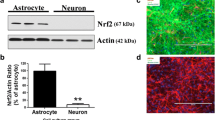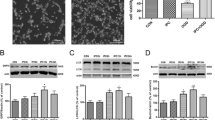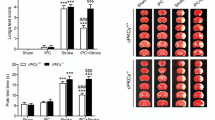Abstract
Oxidative stress has long been implicated in the pathogenesis of various neurodegenerative disorders such as Alzheimer’s disease and stroke. While high levels of oxidative stress are generally associated with cell death, a slight rise of reactive oxygen species (ROS) levels can be protective by “preconditioning” cells to develop a resistance against subsequent challenges. However, the mechanisms underlying such preconditioning (PC)-induced protection are still poorly understood. Previous studies have supported a role of ERK5 (mitogen-activated protein [MAP] kinase 5) in neuroprotection and ischemic tolerance in the hippocampus. In agreement with these findings, our data suggest that ERK5 mediates both hydrogen peroxide (H2O2)-induced PC as well as nerve growth factor (NGF)-induced neuroprotection. Activation of ERK5 partially rescued pheochromocytoma PC12 cells as well as primary hippocampal neurons from H2O2-caused death, while inhibition of ERK5 abolished NGF or PC-induced protection. These results implicate ERK5 signaling as a common downstream pathway for NGF and PC. Furthermore, both NGF and PC increased the expression of the transcription factor, KLF4, which can initiate an anti-apoptotic response in various cell types. Induction of KLF4 by NGF or PC was blocked by siERK5, suggesting that ERK5 is required in this process. siKLF4 can also attenuate NGF- or PC-induced neuroprotection. Overexpression of active MEK5 or KLF4 in H2O2-stressed cells increased Bcl-2/Bax ratio and the expression of NAIP (neuronal apoptosis inhibitory protein). Taken together, our data suggest that ERK5/KLF4 cascade is a common signaling pathway shared by at least two important mechanisms by which neurons can be protected from cell death.









Similar content being viewed by others
References
Akaogi K, Nakajima Y et al (2009) KLF4 suppresses estrogen-dependent breast cancer growth by inhibiting the transcriptional activity of ERalpha. Oncogene 28(32):2894–2902
Aliaghaei A, Khodagholi F, et al (2014) Conditioned media of choroid plexus epithelial cells induces Nrf2-activated phase II antioxidant response proteins and suppresses oxidative stress-induced apoptosis in PC12 Cells. J Mol Neurosci
Angeloni C, Motori E et al (2011) H2O2 preconditioning modulates phase II enzymes through p38 MAPK and PI3K/Akt activation. Am J Physiol Heart Circ Physiol 300(6):H2196–H2205
Briones AM, Touyz RM (2010) Oxidative stress and hypertension: current concepts. Curr Hypertens Rep 12(2):135–142
Cao Y, Liu JW et al (2007) Synergistic protective effect of picroside II and NGF on PC12 cells against oxidative stress induced by H2O2. Pharmacol Rep 59(5):573–579
Cavanaugh JE, Jaumotte JD et al (2006) Neuroprotective role of ERK1/2 and ERK5 in a dopaminergic cell line under basal conditions and in response to oxidative stress. J Neurosci Res 84(6):1367–1375
Chang S, Jiang X et al (2008) Exogenous low dose hydrogen peroxide increases hypoxia-inducible factor-1alpha protein expression and induces preconditioning protection against ischemia in primary cortical neurons. Neurosci Lett 441(1):134–138
Cho YG, Song JH et al (2007) Genetic and epigenetic analysis of the KLF4 gene in gastric cancer. APMIS 115(7):802–808
Clark PR, Jensen TJ et al (2011) MEK5 is activated by shear stress, activates ERK5 and induces KLF4 to modulate TNF responses in human dermal microvascular endothelial cells. Microcirculation 18(2):102–117
Clark VE, Erson-Omay EZ et al (2013) Genomic analysis of non-NF2 meningiomas reveals mutations in TRAF7, KLF4, AKT1, and SMO. Science 339(6123):1077–1080
Cundiff P, Liu L et al (2009) ERK5 MAP kinase regulates neurogenin1 during cortical neurogenesis. PLoS One 4(4):e5204
Davies SP, Reddy H et al (2000) Specificity and mechanism of action of some commonly used protein kinase inhibitors. Biochem J 351(Pt 1):95–105
Dijkmans TF, van Hooijdonk LW et al (2009) Identification of new Nerve Growth Factor-responsive immediate-early genes. Brain Res 1249:19–33
Dirnagl U, Becker K et al (2009) Preconditioning and tolerance against cerebral ischaemia: from experimental strategies to clinical use. Lancet Neurol 8(4):398–412
Dong HM, Huang L (2009) Role of the transcription factor Kruppel-like factor 4 (KLF4) in the pathogenesis of atherosclerosis. Zhonghua Xin Xue Guan Bing Za Zhi 37(10):950–952
Fuenzalida K, Quintanilla R et al (2007) Peroxisome proliferator-activated receptor gamma up-regulates the Bcl-2 anti-apoptotic protein in neurons and induces mitochondrial stabilization and protection against oxidative stress and apoptosis. J Biol Chem 282(51):37006–37015
Fukuhara S, Marinissen MJ et al (2000) Signaling from G protein-coupled receptors to ERK5/Big MAPK 1 involves Galpha q and Galpha 12/13 families of heterotrimeric G proteins. Evidence for the existence of a novel Ras AND Rho-independent pathway. J Biol Chem 275(28):21730–21736
Furuichi T, Liu W et al (2005) Generation of hydrogen peroxide during brief oxygen-glucose deprivation induces preconditioning neuronal protection in primary cultured neurons. J Neurosci Res 79(6):816–824
Godmann M, Kosan C et al (2010) Kruppel-like factor 4 is widely expressed in the mouse male and female reproductive tract and responds as an immediate early gene to activation of the protein kinase A in TM4 Sertoli cells. Reproduction 139(4):771–782
Greene LA (1978) Nerve growth factor prevents the death and stimulates the neuronal differentiation of clonal PC12 pheochromocytoma cells in serum-free medium. J Cell Biol 78(3):747–755
Guyton KZ, Liu Y et al (1996) Activation of mitogen-activated protein kinase by H2O2. Role in cell survival following oxidant injury. J Biol Chem 271(8):4138–4142
Hota KB, Hota SK et al (2012) Acetyl-l-carnitine-mediated neuroprotection during hypoxia is attributed to ERK1/2-Nrf2-regulated mitochondrial biosynthesis. Hippocampus 22(4):723–736
Jou MJ (2008) Pathophysiological and pharmacological implications of mitochondria-targeted reactive oxygen species generation in astrocytes. Adv Drug Deliv Rev 60(13–14):1512–1526
Kim DK, Cho ES et al (2001) Adaptive concentrations of hydrogen peroxide suppress cell death by blocking the activation of SAPK/JNK pathway. J Cell Sci 114(Pt 23):4329–4334
Ky N, Lim CB et al (2009) KLF4 suppresses HDACi induced caspase activation and the SAPK pathway by targeting p57(Kip2). Apoptosis 14(9):1095–1107
Lebesgue D, Chevaleyre V et al (2009) Estradiol rescues neurons from global ischemia-induced cell death: multiple cellular pathways of neuroprotection. Steroids 74(7):555–561
Lee BR, Um HD (1999) Hydrogen peroxide suppresses U937 cell death by two different mechanisms depending on its concentration. Exp Cell Res 248(2):430–438
Li RC, Morris MW et al (2008) Neuroglobin protects PC12 cells against oxidative stress. Brain Res 1190:159–166
Li Z, Zhao J et al (2010) KLF4 promotes hydrogen-peroxide-induced apoptosis of chronic myeloid leukemia cells involving the bcl-2/bax pathway. Cell Stress Chaperones 15(6):905–912
Liu L, Cavanaugh JE et al (2003) ERK5 activation of MEF2-mediated gene expression plays a critical role in BDNF-promoted survival of developing but not mature cortical neurons. Proc Natl Acad Sci U S A 100(14):8532–8537
Livak KJ, Schmittgen TD (2001) Analysis of relative gene expression data using real-time quantitative PCR and the 2(−Delta Delta C(T)) Method. Methods 25(4):402–408
Miller AA, Budzyn K et al (2010) Vascular dysfunction in cerebrovascular disease: mechanisms and therapeutic intervention. Clin Sci (Lond) 119(1):1–17
Mo L, Yang C et al (2012) PI3K/Akt signaling pathway-induced heme oxygenase-1 upregulation mediates the adaptive cytoprotection of hydrogen peroxide preconditioning against oxidative injury in PC12 cells. Int J Mol Med 30(2):314–320
Moore DL, Blackmore MG et al (2009) KLF family members regulate intrinsic axon regeneration ability. Science 326(5950):298–301
Murphy LO, Blenis J (2006) MAPK signal specificity: the right place at the right time. Trends Biochem Sci 31(5):268–275
Nair VD, Olanow CW (2008) Differential modulation of Akt/glycogen synthase kinase-3beta pathway regulates apoptotic and cytoprotective signaling responses. J Biol Chem 283(22):15469–15478
Nakahara Y, Northcott PA et al (2010) Genetic and epigenetic inactivation of Kruppel-like factor 4 in medulloblastoma. Neoplasia 12(1):20–27
Nigro P, Abe J et al (2011) Flow shear stress and atherosclerosis: a matter of site specificity. Antioxid Redox Signal 15(5):1405–1414
Obara Y, Yamauchi A et al (2009) ERK5 activity is required for nerve growth factor-induced neurite outgrowth and stabilization of tyrosine hydroxylase in PC12 cells. J Biol Chem 284(35):23564–23573
Obata K, Katsura H et al (2007) Roles of extracellular signal-regulated protein kinases 5 in spinal microglia and primary sensory neurons for neuropathic pain. J Neurochem 102(5):1569–1584
Ohnesorge N, Viemann D et al (2010) Erk5 activation elicits a vasoprotective endothelial phenotype via induction of Kruppel-like factor 4 (KLF4). J Biol Chem 285(34):26199–26210
Ohtsuka M, Fukumitsu H et al (2009) Neurotrophin-3 stimulates neurogenetic proliferation via the extracellular signal-regulated kinase pathway. J Neurosci Res 87(2):301–306
Pan YW, Storm DR et al. (2013) Role of adult neurogenesis in hippocampus-dependent memory, contextual fear extinction and remote contextual memory: new insights from ERK5 MAP kinase. Neurobiol Learn Mem
Park CS, Lee PH et al (2012) Kruppel-like factor 4 (KLF4) promotes the survival of natural killer cells and maintains the number of conventional dendritic cells in the spleen. J Leukoc Biol 91(5):739–750
Pazyra-Murphy MF, Hans A et al (2009) A retrograde neuronal survival response: target-derived neurotrophins regulate MEF2D and bcl-w. J Neurosci 29(20):6700–6709
Pi X, Yan C et al (2004) Big mitogen-activated protein kinase (BMK1)/ERK5 protects endothelial cells from apoptosis. Circ Res 94(3):362–369
Roux PP, Blenis J (2004) ERK and p38 MAPK-activated protein kinases: a family of protein kinases with diverse biological functions. Microbiol Mol Biol Rev 68(2):320–344
Sanchez A, Tripathy D et al (2012) Pigment epithelium-derived factor (PEDF) protects cortical neurons in vitro from oxidant injury by activation of extracellular signal-regulated kinase (ERK) 1/2 and induction of Bcl-2. Neurosci Res 72(1):1–8
Sarkar SN, Huang RQ et al (2008) Estrogens directly potentiate neuronal L-type Ca2+ channels. Proc Natl Acad Sci U S A 105(39):15148–15153
Scapoli L, Ramos-Nino ME et al (2004) Src-dependent ERK5 and Src/EGFR-dependent ERK1/2 activation is required for cell proliferation by asbestos. Oncogene 23(3):805–813
Seidman R, Gitelman I et al (2001) The role of ERK 1/2 and p38 MAP-kinase pathways in taxol-induced apoptosis in human ovarian carcinoma cells. Exp Cell Res 268(1):84–92
Shalizi A, Lehtinen M et al (2003) Characterization of a neurotrophin signaling mechanism that mediates neuron survival in a temporally specific pattern. J Neurosci 23(19):7326–7336
Singh M, Setalo G Jr et al (1999) Estrogen-induced activation of mitogen-activated protein kinase in cerebral cortical explants: convergence of estrogen and neurotrophin signaling pathways. J Neurosci 19(4):1179–1188
Su C, Underwood W et al (2011) ERK1/2 and ERK5 have distinct roles in the regulation of brain-derived neurotrophic factor expression. J Neurosci Res 89(10):1542–1550
Sunadome K, Yamamoto T et al (2011) ERK5 regulates muscle cell fusion through Klf transcription factors. Dev Cell 20(2):192–205
Suzaki Y, Yoshizumi M et al (2002) Hydrogen peroxide stimulates c-Src-mediated big mitogen-activated protein kinase 1 (BMK1) and the MEF2C signaling pathway in PC12 cells: potential role in cell survival following oxidative insults. J Biol Chem 277(11):9614–9621
Suzaki Y, Yoshizumi M et al (2004) BMK1 is activated in glomeruli of diabetic rats and in mesangial cells by high glucose conditions. Kidney Int 65(5):1749–1760
Takahashi K, Yamanaka S (2006) Induction of pluripotent stem cells from mouse embryonic and adult fibroblast cultures by defined factors. Cell 126(4):663–676
Tatake RJ, O'Neill MM et al (2008) Identification of pharmacological inhibitors of the MEK5/ERK5 pathway. Biochem Biophys Res Commun 377(1):120–125
Wang RM, Yang F et al (2006a) Preconditioning-induced activation of ERK5 is dependent on moderate Ca2+ influx via NMDA receptors and contributes to ischemic tolerance in the hippocampal CA1 region of rats. Life Sci 79(19):1839–1846
Wang Y, Su B et al (2006b) Brain-derived neurotrophic factor activates ERK5 in cortical neurons via a Rap1-MEKK2 signaling cascade. J Biol Chem 281(47):35965–35974
Wang W, Pan YW et al (2013) Extracellular signal-regulated kinase 5 (ERK5) mediates prolactin-stimulated adult neurogenesis in the subventricular zone and olfactory bulb. J Biol Chem 288(4):2623–2631
Watson FL, Heerssen HM et al (2001) Neurotrophins use the Erk5 pathway to mediate a retrograde survival response. Nat Neurosci 4(10):981–988
Wiese AG, Pacifici RE et al (1995) Transient adaptation of oxidative stress in mammalian cells. Arch Biochem Biophys 318(1):231–240
Wruck CJ, Claussen M et al (2007) Luteolin protects rat PC12 and C6 cells against MPP + induced toxicity via an ERK dependent Keap1-Nrf2-ARE pathway. J Neural Transm Suppl(72):57–67
Xiao H, Lv F et al (2011) Deprenyl prevents MPP(+)-induced oxidative damage in PC12 cells by the upregulation of Nrf2-mediated NQO1 expression through the activation of PI3K/Akt and Erk. Toxicology 290(2–3):286–294
Yu SJ, Grider JR et al (2012) Up-regulation of brain-derived neurotrophic factor is regulated by extracellular signal-regulated protein kinase 5 and by nerve growth factor retrograde signaling in colonic afferent neurons in colitis. Exp Neurol 238(2):209–217
Zhu S, Tai C et al (2009) Glutamatergic stimulation triggers rapid Krupple-like factor 4 expression in neurons and the overexpression of KLF4 sensitizes neurons to NMDA-induced caspase-3 activity. Brain Res 1250:49–62
Acknowledgements
This work was supported by funds from the American Federation of Aging Research, and American Heart Association to CS, funds from the National Institutes of Health (NIA, AG022550, AG027956), the Alzheimer's Association, and the Texas Garvey Foundation to MS, and funds from the Texas Garvey Foundation, and American Heart Association to RLC.
Author information
Authors and Affiliations
Corresponding author
About this article
Cite this article
Su, C., Sun, F., Cunningham, R.L. et al. ERK5/KLF4 signaling as a common mediator of the neuroprotective effects of both nerve growth factor and hydrogen peroxide preconditioning. AGE 36, 9685 (2014). https://doi.org/10.1007/s11357-014-9685-5
Received:
Accepted:
Published:
DOI: https://doi.org/10.1007/s11357-014-9685-5




